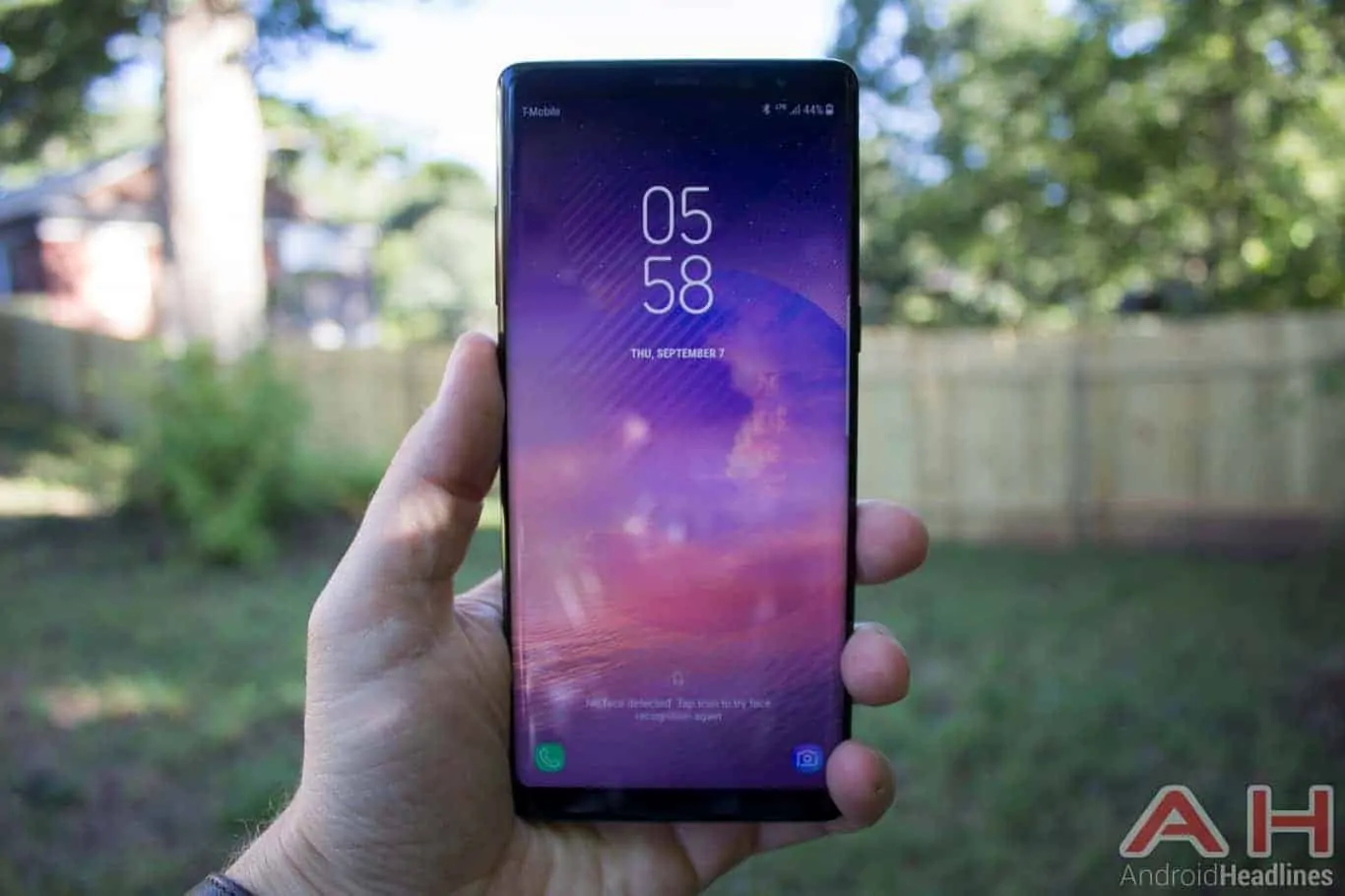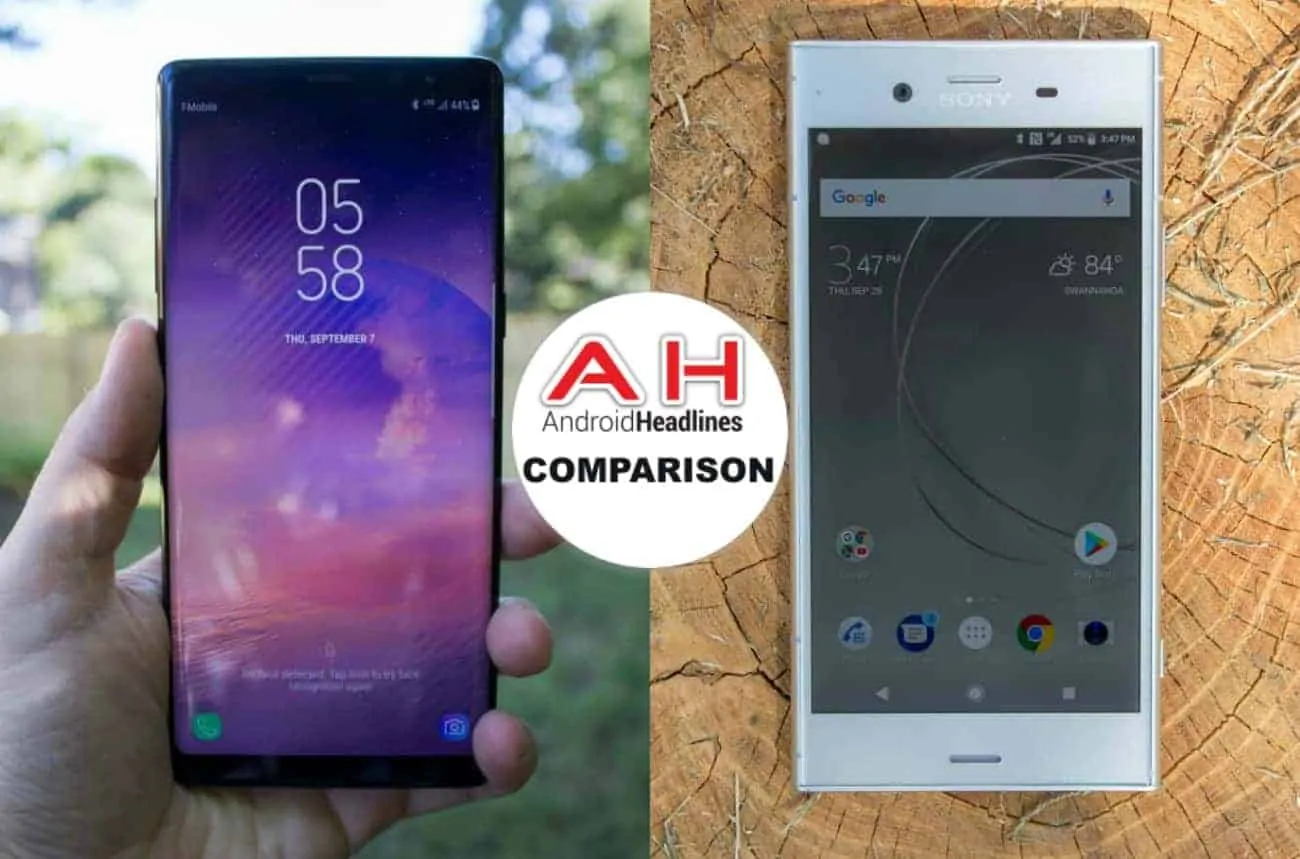Introduction
Do we have a good one for you today – the powerful Samsung Galaxy Note 8 takes on the new Sony Xperia XZ1. Many will argue that this is not a fair fight because the Note 8 is geared to a specific group of customers because of its infamous S Pen. The fact is that the Galaxy Note 8 is Samsung’s top flagship and many people buy the device because of its features – many purchase it and never take the S Pen out of its silo. The Xperia XZ1 is Sony’s current flagship, and as such, deserves to be compared against the best that Samsung can offer. There is a great deal of difference in design philosophy. The Note 8 is slim and sexy with no side bezels and very small top and bottom bezels. The Xperia XZ1 looks rather dated with its larger bezels, a design that Sony has not changed, but only refined, over the years. When it comes to hardware, the gap narrows a bit, but that gap widens when it comes to pricing. Prices are vary a great deal – the Sony Xperia XZ1 coming in at $700 and the Galaxy Note 8 about $960. Is the Note 8 worth the extra bucks or does the Xperia XZ1 have enough to satisfy its user. These questions and more are what we hope to answer during this comparison. Before we look at each individual device, let’s take a look at what they have in common.
The Galaxy Note 8 and the Xperia XZ1 do have a few things in common when it comes to processors and GPUs – they both use the same Qualcomm Snapdragon 835 processor and Adreno 540 GPU. Their displays are wildly different, but the both use Gorilla Glass 5 for their protection. Both devices come with 64GB of expandable memory and both have non-removable batteries with a quick charge option. Both have a fingerprint sensor, but the Xperia XZ1’s is disabled for the US market – no sense in this whatsoever. Hi-Res Audio is found on both devices, as is a 3.5mm headphone jack and they both offer IP68 water and dust resistance. They both have BT 5.0, a USB Type-C port, NFC, and Android Pay.
Please take a thoughtful look at the detailed specifications comparison chart below and here you will see just how these two great devices stack up against one another. After that, we will look at each device in greater depth and point out some of its pros and cons. From all of this information, we will try to determine the winner based on specs and execution of design and functions.
Specifications

Samsung Galaxy Note 8
 Samsung Galaxy Note lovers were so glad that Samsung decided to keep the Note lineup after last year’s Note 7 disaster. Many rumors were swirling around concerning Samsung dropping the Note line altogether, but this year our fears were put to rest when Samsung introduced the Galaxy Note 8. Here you will find the same new Infinity Display it used on its Galaxy S8/S8 Plus models, only super-sized. It has a dual curved display that wraps around the edges literally eliminating any side bezels with a true edge-to-edge viewing experience. After all these years, Samsung eliminated the physical home button in favor of onscreen buttons – that are there only when you need them. The top and bottom bezels are very small on this large device with the bottom bezel void of any function, while the top bezel handles the indicator light, proximity sensor, speaker, and front-facing camera (FFC). This FFC camera handles facial recognition and iris scanning. The fingerprint is still in an awkward position, but now it is separated by the flash from the camera. When there is light, you can quickly unlock the phone with the facial recognition or the iris scanner if you do not wear glasses. If necessary, you can always fall back on using a pin for unlocking the Note 8. Samsung made the usual improvements to the S Pen and software to make it easier to use and more productive. The Galaxy Note 8 is arguably the best looking and most feature-laden smartphone on the market, however, all of this technology comes at a cost of approximately $960.
Samsung Galaxy Note lovers were so glad that Samsung decided to keep the Note lineup after last year’s Note 7 disaster. Many rumors were swirling around concerning Samsung dropping the Note line altogether, but this year our fears were put to rest when Samsung introduced the Galaxy Note 8. Here you will find the same new Infinity Display it used on its Galaxy S8/S8 Plus models, only super-sized. It has a dual curved display that wraps around the edges literally eliminating any side bezels with a true edge-to-edge viewing experience. After all these years, Samsung eliminated the physical home button in favor of onscreen buttons – that are there only when you need them. The top and bottom bezels are very small on this large device with the bottom bezel void of any function, while the top bezel handles the indicator light, proximity sensor, speaker, and front-facing camera (FFC). This FFC camera handles facial recognition and iris scanning. The fingerprint is still in an awkward position, but now it is separated by the flash from the camera. When there is light, you can quickly unlock the phone with the facial recognition or the iris scanner if you do not wear glasses. If necessary, you can always fall back on using a pin for unlocking the Note 8. Samsung made the usual improvements to the S Pen and software to make it easier to use and more productive. The Galaxy Note 8 is arguably the best looking and most feature-laden smartphone on the market, however, all of this technology comes at a cost of approximately $960.
The Infinity Display size was increased from 5.7-inches to 6.3-inches and they gave it a new 18.5:9 aspect ratio. Samsung still uses its Super AMOLED technology and uses a QHD+ display resolution of 2960 x 1440 pixels that generates 521 pixels-per-inch (PPI). Samsung does set the default to an FHD+ (2220 x 1080) resolution to save battery life, but one simply has to go to the display settings to increase it to QHD+. Samsung continues its ‘always-on’ display that helps to save battery life and makes it easier and quicker to check notifications. Just like the Xperia XZ1, the Galaxy Note 8 uses the newest Qualcomm Snapdragon 835 octa-core processor for the US/China models clocked at 2.35 and an Adreno 540 GPU. For EMEA countries, Samsung uses its excellent Exynos 8895 octa-core clocked at 2.3 GHz and the Mali-G71 MP20 GPU for graphics – both processors use the new 10nm technology. The Galaxy Note 8 packs 6GB of DDR4 RAM and has 64GB of expandable memory via a microSD card.
The past couple of years it was rumored that Samsung would use a dual camera setup, especially when the Galaxy S8/S8 Plus arrived in the spring. Next, critics were sure the Note 8 would have dual cameras – finally they were correct. It is a dual 12MP camera affair with the primary camera using a large aperture of f/1.7 to help in low light conditions, PDAF, a dual-tone LED flash, auto HDR, OIS, and 2X Optical Zoom. You can also zoom 10X, but that is a digital zoom. The secondary camera carries all of the same attributes as the primary camera with the exception of a smaller, f/2.4, aperture and no 2X Optical Zoom. The majority of photos are taken with the primary camera, while the secondary camera allows the user to create photos with a bokeh effect – where you focus on one object and then blur the background. Samsung used a big 8MP FFC along with an f/1.7 aperture, auto-HDR, and they even added autofocus. The non-removable 3,300 mAh battery should easily make it through the day. Charging includes Samsung’s Adaptive Fast Charging and Quick Wireless Charging for both Qi and PMA format.
Features carried over to the Note 8 from the Galaxy S8 include Samsung Connect that allows you to control Samsung’s appliances and other home controls, such as the thermostat. Samsung’s DeX Station interfaces the Galaxy Note 8 with a monitor, keyboard, and mouse to give you a near-desktop experience. Samsung’s in-house personal assistant, Bixby, continues to be refined. You can ask Bixby a simple question – like what time is it, or it will provide information from a picture and can translate words on a sign via the camera. The Galaxy Note 8 continues Samsung’s popular heart rate monitor and oxygen saturation sensor that tie into its Samsung Health app. Samsung devices allow you to access not only Android Pay, but also Samsung Pay, which opens up even more possibilities to make mobile payments. The Galaxy Note 8 series is IP68 certified against dust and water-resistance. The item that sets the Note 8 apart from other smartphones is its S Pen and associated apps. Many buy the Note for its size, looks, and power and never remove the S Pen, while others pop it out to do practically everything. It arrives with Android 7.1.1 (Nougat), measures 162.5 x 74.8 x 8.6 mm, and weighs in at a hefty 195 grams. It is available in Midnight Black, Orchid Grey, Maple Gold, or Deep Sea Blue depending where you are located. The Galaxy Note 8 will cost about $960 outright and is available for purchase from just about everywhere.
Sony Xperia XZ1

One look at the new Sony Xperia XZ1 and you will immediately know this is a Sony-designed smartphone. Their main design, although refined, has not changed for years. We must say that it is not a bad looking phone, just a bit dated when compared to the likes of the Galaxy Note 8 and other new designs. The latest trend is to do away with bezels and have the display go as edge-to-edge as possible, but Sony has retained the large bezels, kept smaller displays, and stuck with the Full HD displays. Sony continues with its rather ‘blockish’ look with large bezels on the top and bottom, and smaller FHD displays. On the upside, Xperia XZ1 does have the latest processor, great battery life, stereo speakers, and a solid camera. It will also be the first non-Google smartphone to run Android 8.0 (Oreo) out-of-the-box. The US model, which only works on AT&T and T-Mobile, has the fingerprint sensor inactive for some strange reason.
The Xperia XZ1 sports a 5.2-inch Triluminos IPS LCD display with the normal 16:9 aspect ratio. It is a Full HD display with a pixel resolution of 1920 x 1080 and 424 PPI. Sony uses Corning Gorilla Glass 5 for the display, but metal for the backing. The Xperia XZ1 uses the same Qualcomm Snapdragon 835 clocked at 2.35 GHz and an Adreno 540 GPU found in the Note 8. It sports 4GB of DDR4 RAM and 64GB of expandable memory.
Sony has always provided an excellent camera experience – they make the lenses for many of the smartphones on the market today. The Xperia XZ1 includes a main 19MP sensor with an f/2.0 aperture, laser and phase detection auto focus (PDAF), LED flash, and EIS. The FFC uses a large 13MP sensor with an f/2.0 aperture, and a wide-angle lens with EIS for excellent selfies and video chatting. The Xperia XZ1 packs a rather small 2,700 mAh non-removable battery with support for Quick Charge 3.0. Although the battery is small by today’s standards, you should have no trouble getting through an entire day. It is running on a very efficient OS, a processor that is power conscious, as well as an FHD display.
Although the Xperia XZ1 is a basic rectangle, the corners are rounded nicely to make it a pleasure to hold. The antenna, which was on the back of its predecessor, is now placed on the sides of the device. This new design makes the phone look more solid and less like it was put together in several pieces. The Xperia XZ1 also boasts an IP68 certification for water and dust resistance, stereo speakers, BT 5.0, and NFC. It is available in Black, Warm Silver, Venus Pink, and Moonlit Blue depending on what market you live in and what carrier you use. It will be running Android 8.0 (Oreo) out-of-the-box. The device measures 148 x 73.4 x 7.4mm and weighs in at 155 grams. It will cost you approximately $700.
…And The Winner Is…

The Final Word
The Galaxy Note 8 is the clear winner in specifications in this comparison. In fact, the price is the Xperia’s best defense, and in that case, it would win. However, most users do not buy a smartphone every year, so they want one that looks modern and will not be obsolete in a couple of years – that is the Galaxy Note 8. While both devices use the same processor/GPU setup, the rest of the specs go to the Note 8.
The Note 8 comes with a much larger QHD+ AMOLED display, 18.5:9 ratio, 6GB of RAM, Dual cameras, autofocus on its FFC, a larger battery that offers wireless charging, a working fingerprint sensor, iris scanner, facial recognition, Samsung Pay, and the S Pen.
The Xperia XZ1 has a smaller display, LCD technology, only a Full HD resolution, a single camera (albeit a good one), smaller battery, a non-working fingerprint sensor, and can only be used on AT&T or T-Mobile in the US. It does have stereo speakers and is coming with Android 8.0 Oreo.
Only you can decide if the extra features and usability of the Note 8 are worth the extra money. The Sony Xperia XZ1 just does not have what it takes to be the winner of this comparison.

